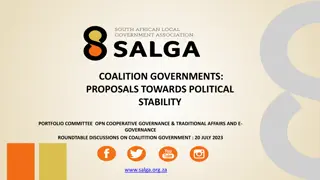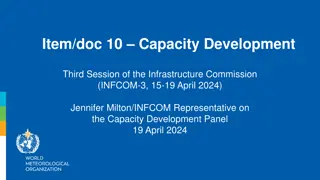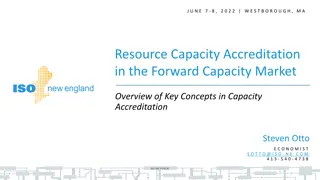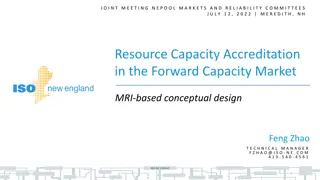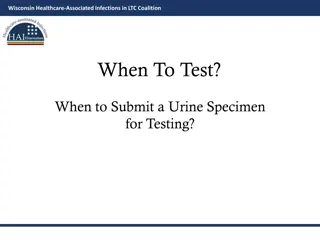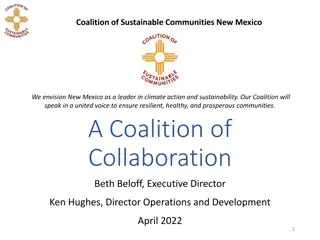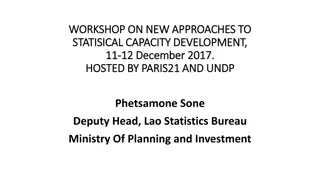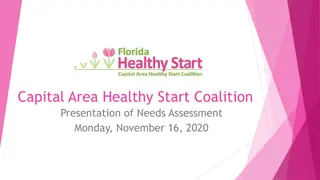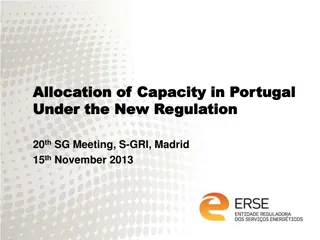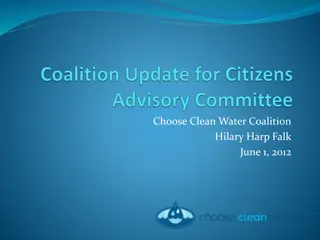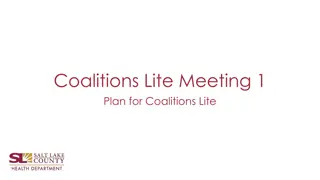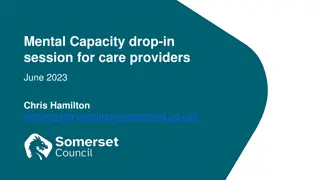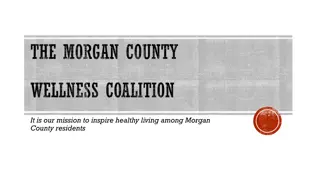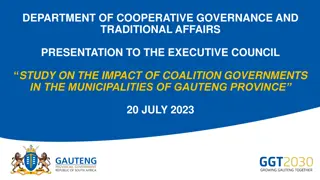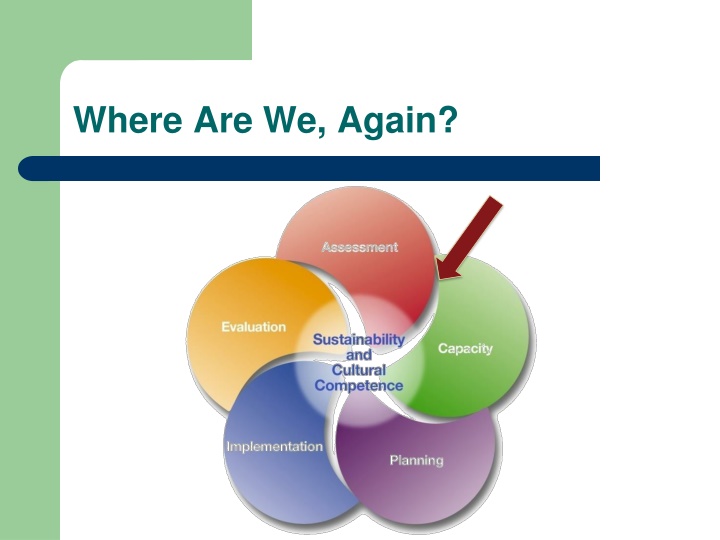
Coalition Capacity & Success Framework
The key elements of coalition capacity building and success, including resources, partnerships, strategic planning, and effective structures. Learn about defining mission and vision statements to guide coalitions towards shared goals and motivating members towards a collective agenda
Download Presentation

Please find below an Image/Link to download the presentation.
The content on the website is provided AS IS for your information and personal use only. It may not be sold, licensed, or shared on other websites without obtaining consent from the author. If you encounter any issues during the download, it is possible that the publisher has removed the file from their server.
You are allowed to download the files provided on this website for personal or commercial use, subject to the condition that they are used lawfully. All files are the property of their respective owners.
The content on the website is provided AS IS for your information and personal use only. It may not be sold, licensed, or shared on other websites without obtaining consent from the author.
E N D
Presentation Transcript
What Does a Coalitions Capacity Need to Include?
Coalition Capacity Various types of resources that a coalition has at its disposal to reach its outcomes Collective knowledge, skill sets, readiness Partnerships and collaborations Consider all the processes and tasks that each step of the SPF requires Levels of resources (Individuals/organizations/community/state/federal)
So How Does Your Coalition Know Their Capacity? https://c2.staticflickr.com/4/3040/2944376209_6eccb4f6d2_b.jpg
What Makes Coalitions Successful? 1) Clarity in mission and vision/goals 2) Effective structures 3) Meaningful meetings 4) Opportunities to build a sense of community 5) Strategic outreach and communication
What Makes Coalitions Successful? 6) Opportunities for member growth and responsibility 7) Builds, uses Champions 8) Meets needs and provides benefits 9) A clear strategic plan and reliance on data 10) Doing projects
#1. The Mission and Vision A strong and clear mission/vision helps articulate the way we see the better future Helps us guide all members of our coalition towards this larger goal Helps motivate individuals towards the shared agenda
#1. The Mission and Vision A mission statement defines the organizations purpose and primary objective A vision statement is values driven, inspirational, and offers a look at what the world would be like if the mission is achieved Write down your personal mission and vision
#1. The Mission and Vision Who knows our Mission Statement? Who knows our Vision Statement? (No Cheating!)
Group Work Get into groups of 4-5 Dissect the Mission / Vision Statements What does it mean? How would we know it is being achieved? What does the coalition do to drive this forward? Does the community understand it? Do we understand it? Identify 4 to 5 key words (themes) that should be considered in interpreting the M/V
#2. Effective Structure Regular meetings Active committees Updated by-laws Executive boards/teams New member orientations
#3. Meaningful Meetings Agendas are actionable and followed Ability to speak and be heard Advertising of meetings Convenient locations Transportation provided if necessary
#4. Sense of Community Informal opportunities to build sense of community Participation in social activities Equal treatment Contributions recognized and rewarded All individuals feel welcome Successes are celebrated, even the little ones
Recognizing Members Based on Their Needs Types of Needs Need to Contribute to the Greater Good Need to Affect Change Need to Gain and Understand Information Need to Gain Physical Possessions Need to Feel Appreciated May change depending on situation Don t assume needs!
How Do We Assess Their Needs? In short ASK! Survey coalition members Conduct individual interviews or focus groups with coalition members Anonymous suggestion boxes LISTEN actively during coalition conversations - What excited a member during that meeting? http://pixabay.com/static/uploads/photo/2014/04/08/15/01/to-write-319302_640.jpg
Building Relationships One at a time Partnerships are built individually Snowball effect Focus on being interested, not interesting Ask questions and take a genuine interest Friendly goes a long way Give reasons to care
Building Relationships Be clear and specific in what your needs are Recognize personal differences in skills, capacities, and interest Show champions added value - fill their need before asking for help! Be persistent willingness to engage will ebb and flow
#5. Strategic Communication the purposeful use of communication by an organization to fulfill its mission - Kirk Hallahan, et al. Defining Strategic Communication. International Journal of Strategic Communication. Vol. 1, Iss. 1, 2007. "What makes communications 'strategic'? Strategic communications does not consist of sending out an occasional press release or publishing an op-ed once a year. It means that an organization treats media relations and communications as important, fully integrated, consistent, and ongoing functions and invests resources in it."-Kathy Bonk, Henry Griggs and Emily Tynes, Strategic Communications for Nonprofits, Communications Consortium Media Center
Why Plan Out Your Communications? https://farm2.staticflickr.com/1022/1125019024_356243621e_o_d.jpg
Strategic Communication Vision Goal(s) Objective(s) Strategies Tactics
#6. Opportunities for Growth Development of new leaders Training and support Buddy systems Committees with serious work Leadership is shared
Community Support Community ownership of prevention effort How has the community demonstrated its commitment to the current prevention effort? Strong leaders (champions) able to leverage political/social capital to affect change Success stories distributed to the community that show the effectiveness of effort
Barriers to Building Member Responsibility Myth of Zero-Sum Game there s only so much work/funding/champions to go around Myth of Resource-Poor Community the community just does not have the resources Fat Grant Syndrome coalition received a big grant, so sustainability is not a problem Overly Comfortable coalition receives funding every year, why worry now?
#7. Champions Sometimes coalitions can attain visibility and recruit members more quickly if they have a powerful champion. A champion can be ANYONE in your coalition with a passion and interest The champion may be a community figure (judge, political leader, business person, civic leader), but they should be someone who is well respected and willing to work to generate support for the new entity
Key Function of a Champion A champion is a strong leader who leverages community support ( political/human capital ) to help coalition reach outcomes https://c2.staticflickr.com/4/3400/4625408407_c2f81c9749_z.jpg Who are the champions in your coalition?
Strategies to Recruit Champions Identify individuals dedicated to cause Take advantage of coalition members network connections Appealing to potential for success will help to recruit/retain champions Benefits of membership Provide many different opportunities for participation
How Do We Develop Champions? Starting with ourselves Understanding what motivates us, and how this may be similar or different to what motivates our coalition members
Some Things to Consider Leadership Handout Authoritative Pacesetting Affiliative Coaching Democratic Commanding When might each be appropriate?
Principles of Effective Leaders Challenge the process Inspire a shared vision Enable others to act Model the way Encourage the heart
Methods People Use in Leadership Command of power vs. sharing power Rally of political will Building of relationships, building of team Setting an example Persuasion of others
Leadership: Issues that Hinder Delegation of responsibility Our coalition is a catalyst, and so are we! Too many responsibilities and not enough time Tendency towards ACTION without a PLAN Paid Staff vs. Volunteers
Who are Your Champions? NAME MOTIVATOR GOAL ACTIVITY TIMELINE John Doe
How do we Build Champions? (Individuals) Clear Goals and Targets Achievable and Purposeful Clearly defined roles that match skills and interests Tasks and Deadlines Interdependence among team members The Leader / Follower Relationship (fluidity!)
How do we Build Champions? (Individuals) Open communication An environment that fosters communication across levels of leadership through a formalized process An environment that encourages new ideas From both the leaders and the followers and sometimes these roles change! An ability to meet people s needs
#8 Meeting the Community Needs Resource Lists and contacts Workshops with experts Meeting individual member needs Regular surveys of memberships Regular meetings Ensuring the community knows its value
Your Capacity Analysis What would the community be like without our prevention efforts? Does the community know what they d be missing without us? What are the things we can t do without the community?
#7. Meeting Needs and Providing Benefit Working on common issues of critical concern Utilizing community resources Staying on top of local issues Relying on outside speakers to enhance knowledge Relying on local data when possible
#9. Needs and Assets Analysis Who are the prevention players ? What are the current strategies in place? Guided by evidence? Evaluation reports that assess the effectiveness of strategies? What important gaps exist in the prevention effort?
And Finally Doing Projects! Regular development of strategic plan Plans are based on data and input from members Activities are evaluated Organizes visible projects that make a difference to members Action plans identify roles and responsibilities
Action Plans that Work NAME MOTIVATOR GOAL ACTIVITY TIMELINE John Doe Appreciation Oversee Compliance Checks 1. Chair Compliance Sub- committee Hold Monthly Meetings Ensure 50 compliance checks occur in next 60 days 1. Immediately 2. Monthly beginning next month 3. Over next 60 days 2. 3.
So How Does Your Coalition Know Their Capacity? https://c2.staticflickr.com/4/3040/2944376209_6eccb4f6d2_b.jpg
Some Final Tips Begin with action-oriented work plan Start with an activity that can be achieved quickly and easily Build off initial success and celebrate victories Build administrative capacity to keep organized Hold regular, productive meetings
Remember Every member can be a Champion! It is our job to identify the passion in each coalition member We must continue to recruit and build new leaders With a strong group of Champions, we will prevent burnout and increase output

